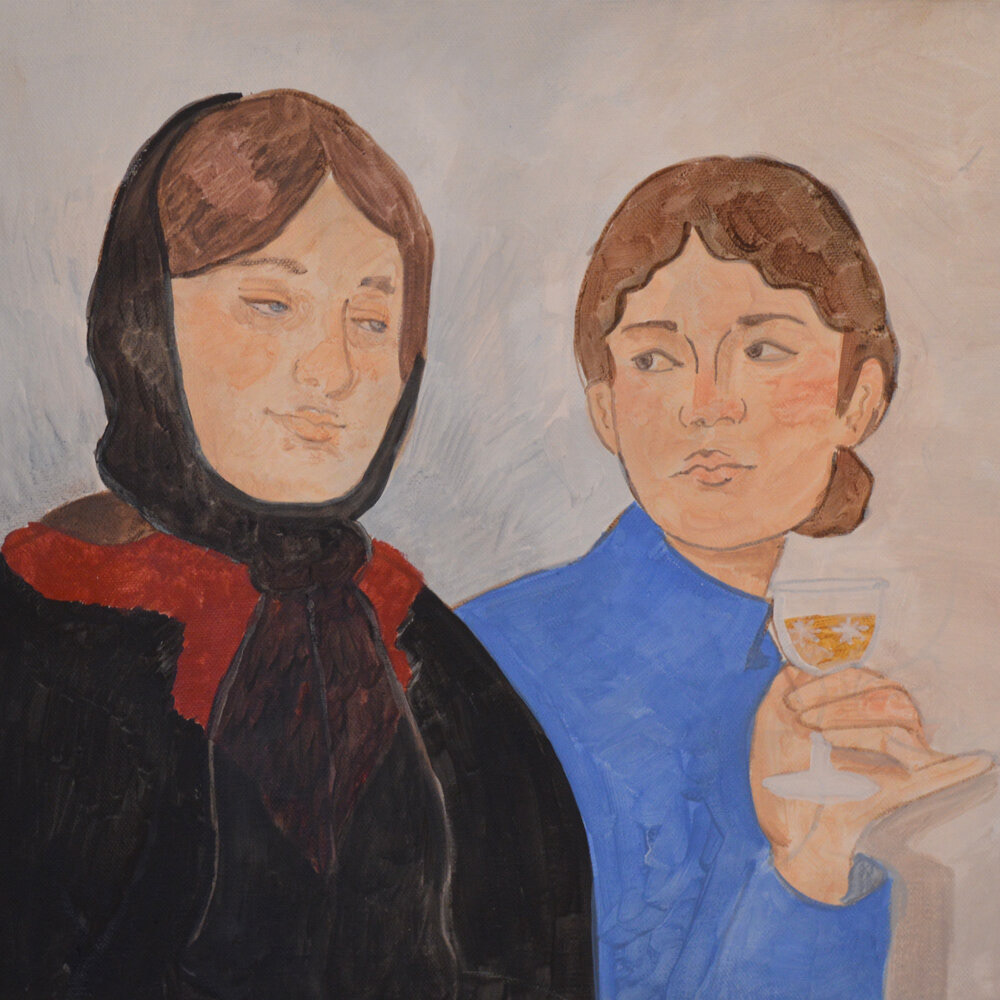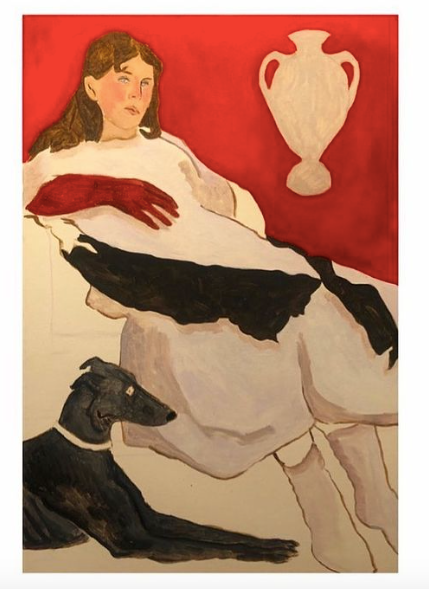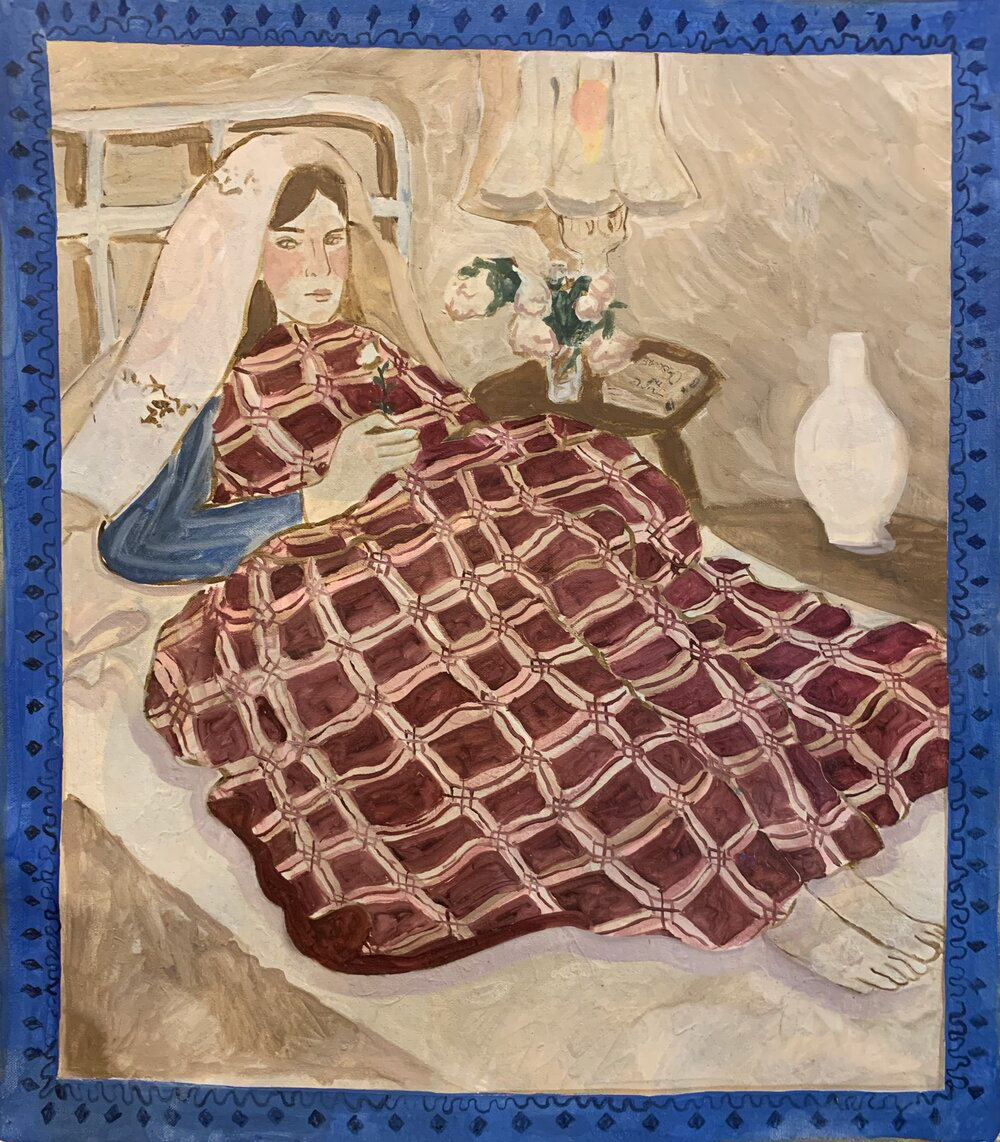Des scènes aux atmosphères d’antan, teintées de folklores des pays de l’Est ou encore de l’aristocratie de l’ère victorienne, caractériseront notre nouvelle semaine à la rencontre d’un autre talent.
Cet univers pluriel et singulier est celui de Beatrice Dahllöf, jeune artiste australienne des environs de la ville de Victoria.
Originaire de Pologne, Beatrice Dahllöf a grandi dans une famille de conteurs. Depuis petite, l’artiste a l’habitude d’écouter ces fabuleuses histoires notamment par sa grand-mère avec qui aujourd’hui elle en invente et écrit à son tour. De cet héritage et de son intérêt personnel pour le folklore en général, l’artiste matérialise cette tradition orale en nous contant à son tour des histoires, qu’elle puisse de son quotidien, au moyen de son pinceau.
A cette tradition forte s’ajoute un symbolisme fort pour chaque objet décoratif dont elle accorde un intérêt et un sens tout particulier. Si ses compositions paraissent souvent dépouillées à première vue la place des objets quant à eux n’y sont jamais placés par hasard.
A travers les peintures de Béatrice, c’est toute une tradition et un patrimoine ancestral qui se transmet de génération en génération qui nous est offert.
Je suis très honorée d’avoir eu l’opportunité d’échanger avec Beatrice et de vous transmettre à mon tour son univers.
Cet univers pluriel et singulier est celui de Beatrice Dahllöf, jeune artiste australienne des environs de la ville de Victoria.
Originaire de Pologne, Beatrice Dahllöf a grandi dans une famille de conteurs. Depuis petite, l’artiste a l’habitude d’écouter ces fabuleuses histoires notamment par sa grand-mère avec qui aujourd’hui elle en invente et écrit à son tour. De cet héritage et de son intérêt personnel pour le folklore en général, l’artiste matérialise cette tradition orale en nous contant à son tour des histoires, qu’elle puisse de son quotidien, au moyen de son pinceau.
A cette tradition forte s’ajoute un symbolisme fort pour chaque objet décoratif dont elle accorde un intérêt et un sens tout particulier. Si ses compositions paraissent souvent dépouillées à première vue la place des objets quant à eux n’y sont jamais placés par hasard.
A travers les peintures de Béatrice, c’est toute une tradition et un patrimoine ancestral qui se transmet de génération en génération qui nous est offert.
Je suis très honorée d’avoir eu l’opportunité d’échanger avec Beatrice et de vous transmettre à mon tour son univers.
L'artiste Beatrice Dahllöf
Could you introduce yourself?
My name is Beatrice Dahllöf, I’m 22 and I was born in a small town in the western district of Victoria, Australia. In 2020 I completed my honours year of Fine Arts specialising in painting at RMIT University and in march of this year I will be starting my Masters in Cultural Materials Conservation.

How's it Feel? , 2020, 41 x 41 cm, Oil on Canvas
The depiction of woman portrait is central in your paintings and I notice that from portrait to portrait the female modele looks alike between its. Is it a self representation or is it a depiction of a person from your personal circle?
The reason all the women look so similar is because they all generally come from drawings of myself. I am a very shy person and was always too scared to ask other people to pose for me, I am also incredibly impatient and when the inspiration strikes for a painting I feel I must make it in that very moment. As I am always available as a model it makes it very easy for me. During the strict lockdowns in Victoria last year I found that I could pose myself in various ways, photograph it and then collage the photographs together, to make scenes with more people, which also has a brilliant disjointed feeling to some of the work.
That being said, I do sometimes venture out from just painting myself, but I find that no matter what face I paint I am always putting my own features into it.
By looking your paintings its remembrer me a lot the avant-garde paintings whom subjects were interested by the folklore. I think to Natalia Goncharova for example. I saw an icon in one of your painting, the women often wear scarf on their heads.. What is your link to the folkloric art ? Could you speak about those subjects? Are they a reference for you?
Folklore and story telling is essential to more work and life. I grew up in a polish family full of story tellers. My grandmother is probably the greatest story teller I know, we still make up stories together today. Her father before her was also brilliant at this, she has created many Wycinanki (traditional polish paper cut outs) that tell his tales. I always believed everything my grandma said to be true, such as one night as a child she was visited by the Baba Yaga and danced with her in her living room. Because of this I have never doubted folklore and have always had a strong connection to it. That is why in so many paintings my figures wear headscarves or act out stories as characters from traditional Slavic tales.
On top of this I also adore Australian folklore. When I was a child Ned Kelly was my hero, although his story is not exactly folklore but he is definitely a folk hero and he is one of the many incredible legends that shape the way I feel about the Australian landscape. The Western District where I come from has a big history of people reporting Bunyips emerging from various bodies of water, along with a great big black cat that’s suppose to stalk the Bellarine Peninsula. All of these stories make my mind go crazy, I love thinking about what people in the past may have seen or heard and how they interpreted it, either as a paranormal occurrence or as a true story that has shaped various cultures and traditions.

Quarantine self portrait
Is the subject of your painting coming from imagination or from your daily life? Could you talk about your creative process?
I take the subject from both places. The biggest influence in my life and art is storytelling. Really when I create art a lot of the time I am trying to heighten my everyday experiences to those of a biblical parable or folkloric fairytale. I have always been interested in Carl Jung’s concept of the unconscious and the imagination being one of the most important things we possess. He wrote that the most important question you can ask yourself is “what myth am I living?” I try to remind myself of this question everyday and apply it to most things I do.
In terms of my creative process I just try to read and watch and listen to as many things as possible. Inspiration comes from everywhere, sometimes it might be a word or a complete story, but really, as soon as an image comes into my head I make it. I don’t like to put anymore emphasis on it than that, I hate spending a lot of time on things, I become bored very easily and it also takes the magic out of the work for me.
Yours portraits don’t give us any spatio-temporal landmarks: the background is paint with solid colors. And you seem attached to the decorative objects: they are often in your composition. Could you speak about it?
Ever since I was little I have had a great love for the Victorian era. It was one of the only things that could keep my attention and I would read book after book about it over and over again. One thing that really draws me to this time is the decadence of the era combined with all of its macabre underpinnings. I loved the importance they put into so many things like flowers, fruit, colours. I think a lot of wealthier victorians were trying to live in that myth, the way Jung spoke about. I loved viewing paintings and photographs of the aesthetic era and seeing rooms jammed full of ceramics, fans, rugs, tapestries, and the rooms were always so dark.
I have also always had a great love of symbolism if I haven’t already made that abundantly clear and I love the different meanings that objects can convey. My first experience of this in work was Degas’ ‘interior’ when I was 15. I remember reading about the prominence given to the sewing box in that painting and what the implications of it were. I could not believe that a small box in the middle of a painting held so much meaning and contributed so much to a story. Since that time I have loved symbolism, but particularly symbols through decorative objects.
At home we have always had a large collection of objet d’art so many of the pieces in my works are ones that I live with everyday.
About the solid coloured backgrounds, I think that the images are so firmly in a certain place in my mind I don’t feel the need to create the space, I already know what it is.

You create some double portrait. And your frame highlights the bust and the gaze that croisses between the women. Could you talk about those paintings?
My dream when it comes to making work is to create large narrative scenes.
But it is only recently that I have become confident in my painting skills, although i have painted from a young age, and I find it hard sometimes to get out of my own head enough to envision group works. I think there is something in me at the moment that is stopping myself from expanding outwards, perhaps there is something I need to address or work out with these close up women.
I have noticed slowly through the years though that my work has been expanding. First it was faces, now I have been painting full bodied women (not that I have shown many of these) and now I’m slowly working with having more than one figure in a work. Perhaps this is just as I become more confidant as a painter and am better able to expand my world view.
Do you have any future projects to share with us?
At the moment I’m working towards an exhibition with a good friend of mine that will hopefully be sometime in the next 6 months. I’m also hoping to finally put some paintings and prints up for sale, I’m particularly bad at self promotion so this is a big step for me haha. At this point I’m just working towards making more art consistently which is equal parts exciting and terrifying.

Vox Celmatis In Deserto, 2020, 46 x 35.5 cm, Oil on Canvas


Self Portrait in Bed as Bride 2020 52 x 45.5 cm, Oil on Canvas
Pour continuer à suivre le travail de Beatrice vous pouvez vous rendre sur son site internet et sur son Instragram: